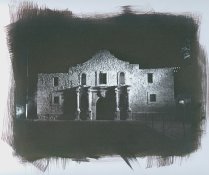Richard Puckett
Member
I am Richard Puckett, introducing my Texas Chrysotype process, which was presented in the March/April 2012 issue of View Camera. If you have not got access to back issues of VC, visit unblinkingeye.com.
The process is characterized by:
I have put six samples up in my APUG album. Incidentally, I have developed a (significant) variation on the process that makes it equally simple to print with palladium and platinum, as well as gold and platinum. I will be announcing that process later this year in another magazine article.
The process is characterized by:
- Fine grain
- Excellent Dmax and Dmin with good tonal separation between the two extremes. In other words, true continuous-tone images
- Dry print out. You determine correct exposure by direct examination.
- No humidification of paper. For the January 2012 proof of process demonstration to members of the Austin Alternative Processes Group, I used Arches Platine stored in a closed plastic bin with 4 pounds of silica gel. RH was 29%.
- Economical 10% gold chloride solution.
- Key is the addition of ascorbate to ammonium ferric oxalate. Some of the gold precipitates out to form a foundation that smooths out the image and greatly extends its tonal range.
- Absolutely repeatable. Make print after print of the same negative.
- Standard clearing as for ziatypes.
- Contrast control by various means.
I have put six samples up in my APUG album. Incidentally, I have developed a (significant) variation on the process that makes it equally simple to print with palladium and platinum, as well as gold and platinum. I will be announcing that process later this year in another magazine article.







